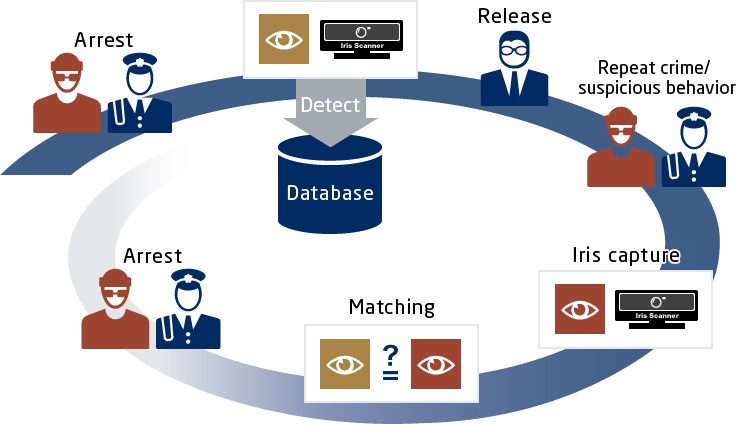The iris is the coloured, doughnut-shaped portion of the eye behind the cornea and surrounds the pupil. A person’s iris pattern is unique and remains unchanged throughout life. Also, covered by the cornea, the iris is well protected from damage, making it a suitable body part for biometric authentication.

Features of iris recognition
Iris recognition is a highly sought-after method of biometric authentication, especially in sectors such as law enforcement and border control. This is because iris recognition is an extremely strong biometric that is highly resistant to false matches. It also offers high-speed searches against large databases.
Some of the key features of iris recognition include:
- Highly accurate and fast, iris recognition boasts of having top-class precision among different types of biometric authentication technologies.
- Remains unchanged throughout life. (This does not constitute a guarantee.)
- Since the iris is different between the left and right eye, recognition can be performed separately by each eye.
- Possible to distinguish twins.
- As long as the eyes are exposed, iris recognition can be used even when the subject is wearing a hat, mask, eyeglasses or gloves.
- Because of using an infrared camera, recognition is available even at night or in the dark.
- Without the need to touch the device, contactless authentication is possible, making it hygienic to use.
Whilst iris recognition is currently a fairly niche form of biometric authentication, especially when compared to facial and fingerprint recognition, we can expect to see a much wider rollout of iris recognition technology moving forward as businesses and government agencies look to limit the number of touchpoints a person has to go through whilst retaining a high level of security.
How does iris recognition work?
The process of Iris recognition involves the use of a specialised digital camera. The camera will use both visible and near-infrared light to take a clear, high contrast picture of a person’s iris.
With Iris recognition, the camera focuses in on your eye and locates the centre of the pupil, edge of the pupil, edge of the iris and your eyelids and eyelashes. This is then divided into blocks and converted into feature values to quantify the image.
Matching is then performed with feature data previously extracted in the same methods.
You can read more about iris recognition, the advantages and disadvantages in our blog, What is iris recognition and how does it work?

Enhancing security through continued R&D and use of multimodal technologies
NEC invests heavily in R&D to ensure that we continue to bring cutting-edge solutions to market. From our global R&D laboratories located all across the globe to our Open Innovation Centre located in Singapore, we are committed to advancements in biometric technology to improve safety and security in the home, workplace and in the travel sector.
NEC R&D
When it comes to iris recognition, NEC has been advancing our technology in this area since we first started R&D in biometric authentication technology back in the 1970s.
- NEC has patented the entire process from the detection of the iris from photographed images, extraction of the feature values, matching of features, to noise removal.
- NEC is continually carrying out R&D on iris recognition by leveraging its knowhow in fingerprint identification, face recognition, and other biometric authentication technologies that have been recognised as the world’s most accurate.
- NEC offers the most suitable solution fine-tuned to the customer’s environment.
Multimodal Biometrics
- NEC offers solutions that combine fingerprint identification, face recognition, and other proprietary biometric authentication technologies.
NEC aims to realise a safe, secure, efficient, and equal society by expanding iris recognition solutions for criminal investigation, immigration control, and national identification systems in different regions around the world.
What is iris recognition used for?
Whilst the potential uses for iris recognition are wide-ranging, currently, there are three main sectors that are utilising iris recognition as a biometric authentication technology: immigration, national ID, and crime investigation. Here is a little bit more about how each of those sectors is using iris recognition technology:
Immigration Control
In response to the increasing threats of terrorism around the world, NEC contributes to a safe and secure society by enhancing the stringency of immigration control. Our iris recognition solution offers improved security and smooth personal identification amidst the increasing movement of people between countries.
- The iris is photographed, and the image is matched with the government’s immigration control database during exit or entry procedures at the passport control booth, enabling rapid and stringent personal authentication.
- Our solution provides improved security through stringent recognition, as well as improved convenience through smooth authentication procedures.

National ID
NEC promotes equal access to administrative services by providing legal identification for all citizens. By enhancing the security of national ID systems, our solution contributes to realising more advanced national identification services.
- Iris recognition is used as one of the methods for acquiring biometric data needed for issuing unique IDs.
- Accurate and fast authentication is possible even without an ID card.
- Combined use with mutually complementary biometric data, such as fingerprint and face, enables rigid personal authentication and a robust approach against impersonation.
- In addition to National ID, the solution is suitable for passports, driver’s licenses, and voter ID systems.

Crime Investigation
A multimodal biometrics database for managing multiple biometric authentication data is created by taking images of the face, fingerprint, and palm print, as well as the iris.
- Combining with fingerprint and other biometric authentication systems enables more accurate identification of an individual.
- Combined use of biometric data allows recognition even when the fingerprint, for example, could not be used for identification due to injury.

Summary
NEC’s Iris Recognition technology achieved the highest matching accuracy evaluation in the recent Iris Exchange (IREX) IX evaluations of automated Iris Recognition algorithms performed by the U.S. National Institute of Standards and Technology (NIST).
Couple this with our facial recognition technology, which has ranked first in the NIST’s benchmark tests four consecutive times, in addition to the company’s fingerprint recognition technology also ranking first. Each of these technologies belongs to NEC’s biometric authentication brand, “Bio-IDiom” and forms NEC’s complete suite of biometrics solutions.
Talk to the team today about any of our biometric solutions.
